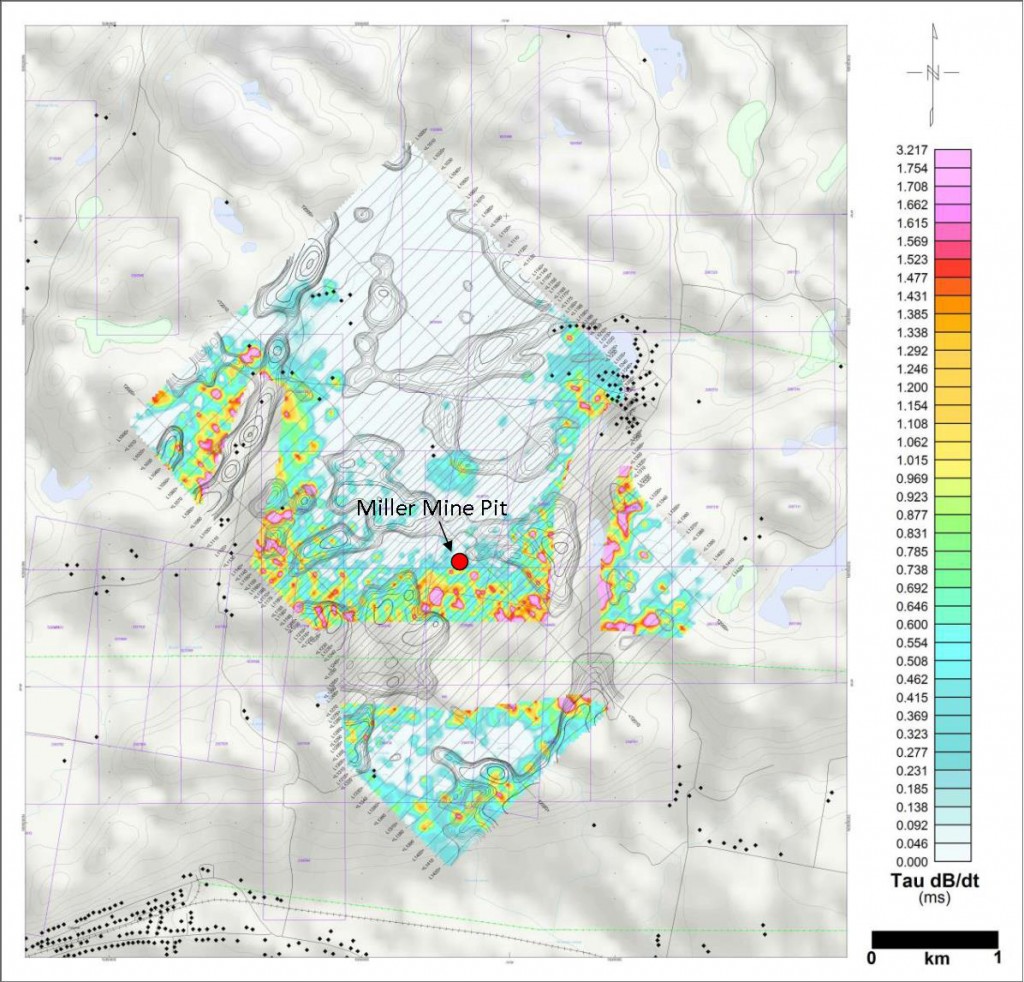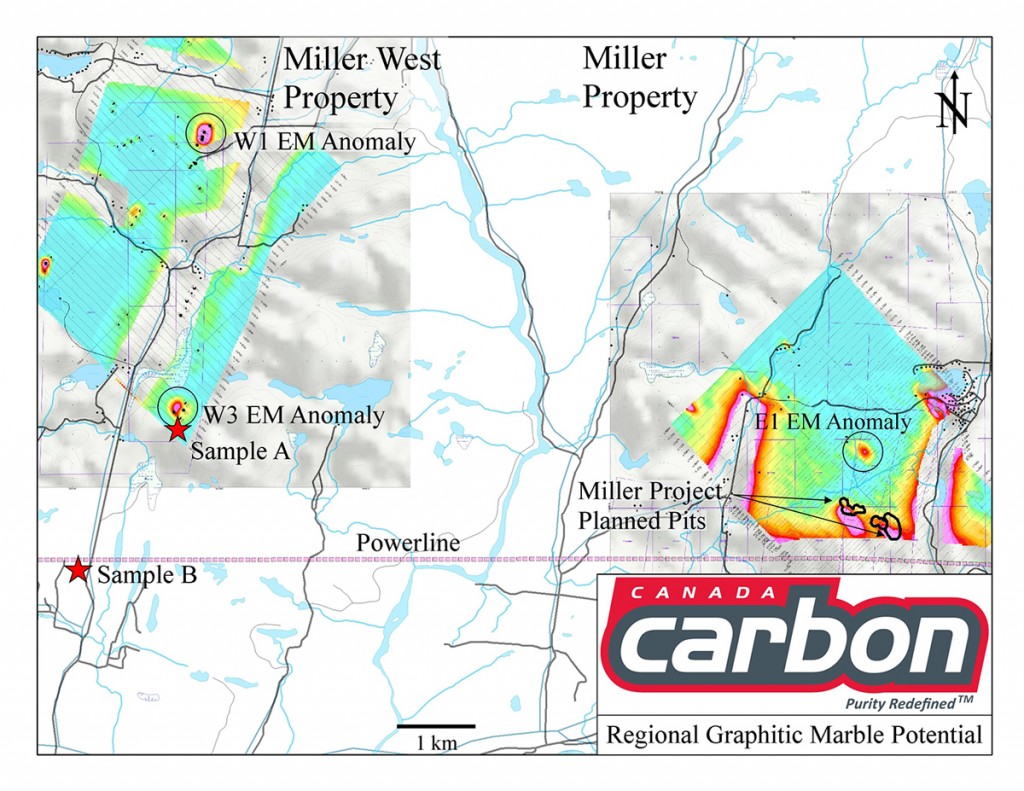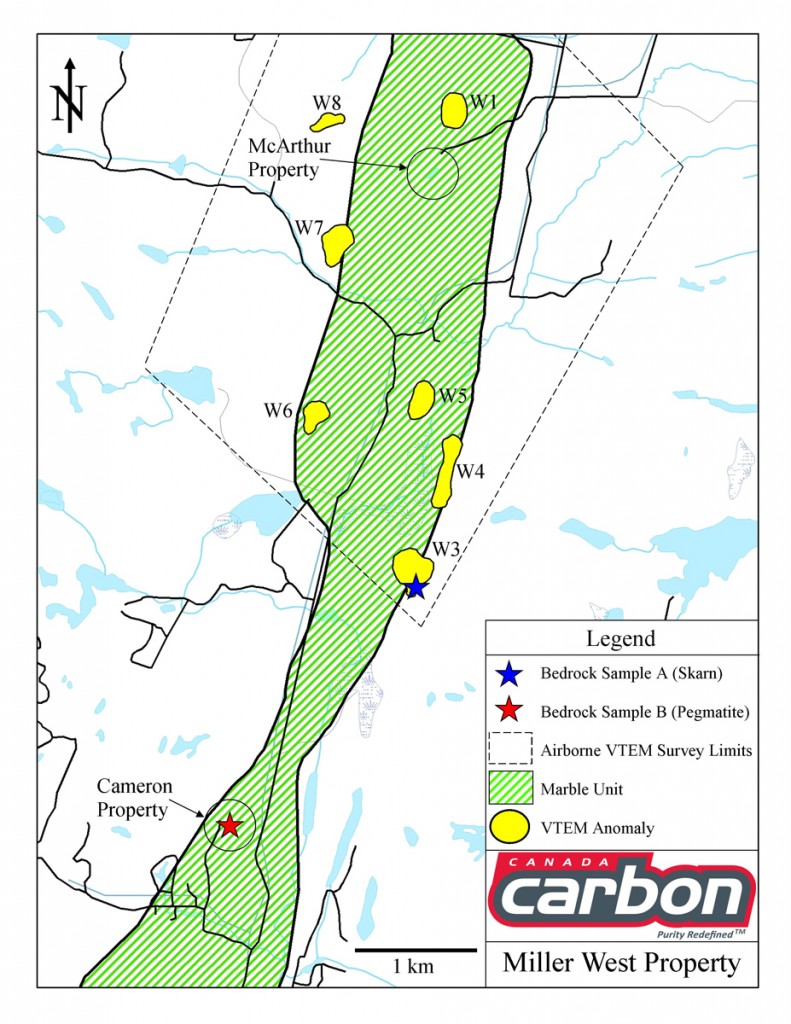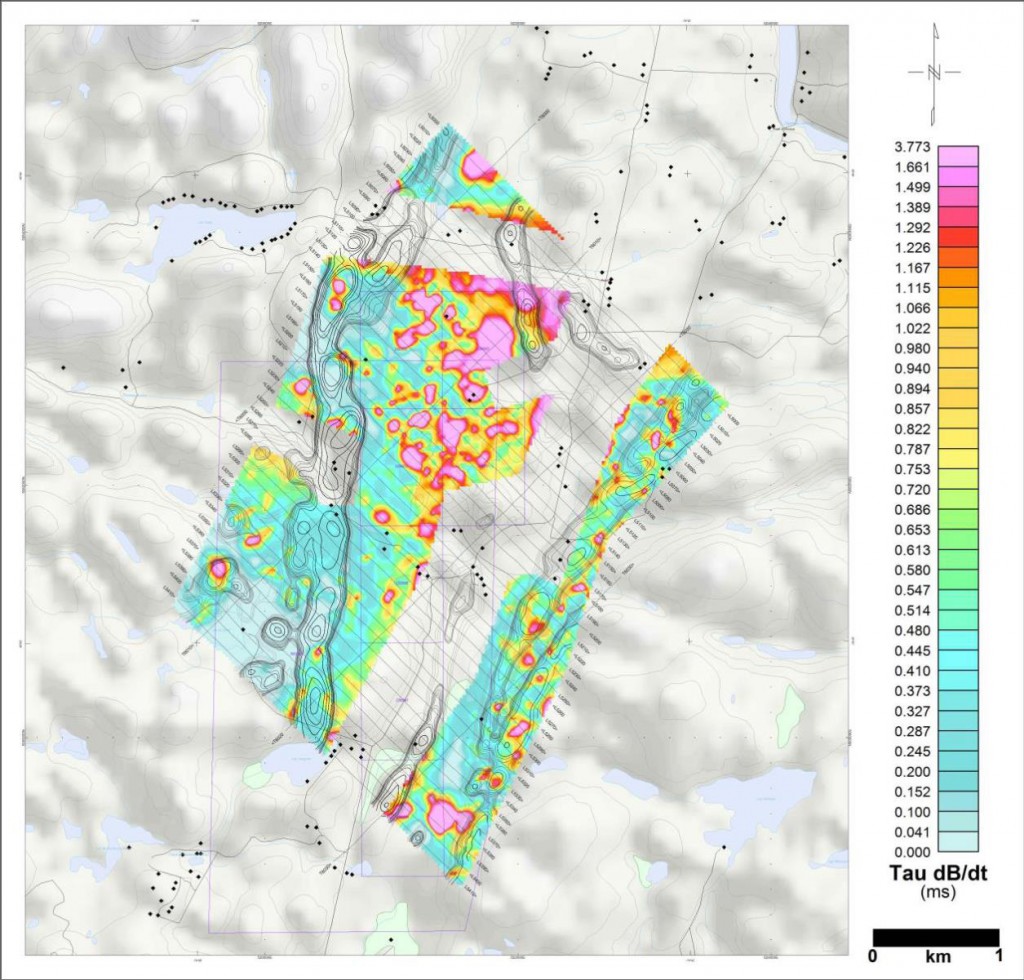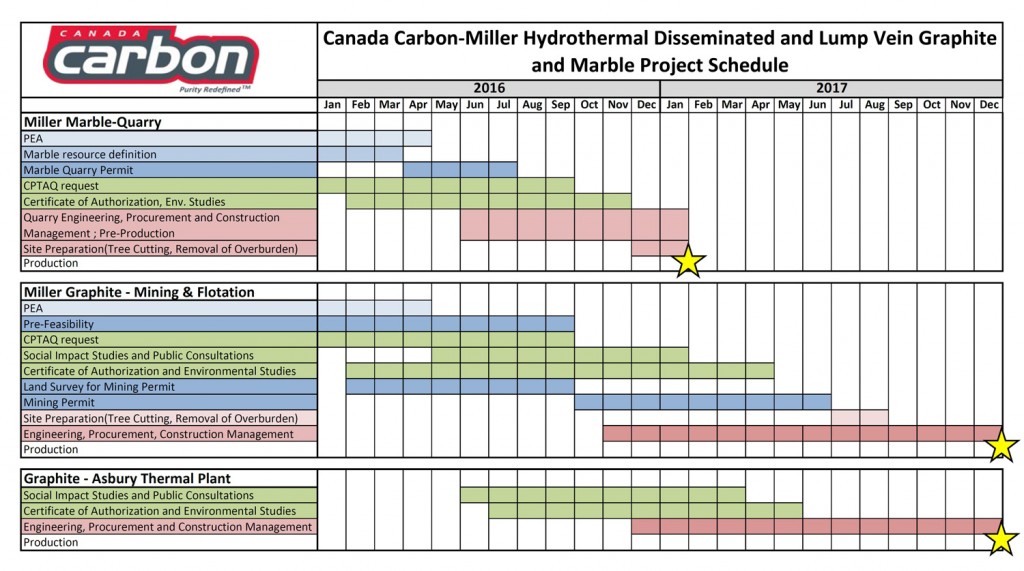The Most Advanced Nuclear-Grade Natural Graphite Project in North America
Following thermal treatment, Sample A yielded graphite of 99.9992 % carbon total (“Ct”) purity, with an Equivalent Boron Concentration (“EBC”) of 0.83 parts per million (“ppm”). Sample B was upgraded to 99.9997% Ct purity, with an EBC of 0.74 ppm. These results were obtained using the same metallurgical process parameters more fully described in the Company’s technical report and preliminary economic assessment, which was filed to SEDAR on April 14th 2016, and are substantially equivalent to the results obtained from the thermal upgrading of flotation concentrate from the Company’s pilot plant program. The analytical results reported here indicate that the thermally upgraded samples from the Company’s West Block claims are suitable for nuclear applications. Complete information about EBC calculations and GDMS analysis can be found in the news release dated November 18th 2014.
Both concentrate samples were assessed at Evans Analytical Group (Liverpool, New York) by GDMS before and after thermal treatment. Flotation concentrate A was found to have an overall purity of 99.3% Ct (pre-treatment), with 32 elemental contaminants detected (range 0.08 to 2600 ppm). After thermal treatment, only six elemental contaminants were detectable at ultra-trace levels, and are best reported in parts per billion (“ppb”) concentrations: boron (220 ppb), aluminum (140 ppb), silicon (5200 ppb), nickel (80 ppb), molybdenum (2300 ppb) and tungsten (260 ppb). Flotation concentrate B was found to have an overall purity of 99.7% Ct (pre-treatment), with 24 elemental contaminants detected (range 0.05 to 1500 ppm). After thermal treatment, only four elemental contaminants were still detectable: boron (130 ppb), silicon (2300 ppb), nickel (50 ppb), and tungsten (130 ppb). The following table shows the grade of the samples as they went through the upgrading processes.
| Sample | Head Grade (Cg%) | Flotation Concentrate (Ct%) | Post-Treatment (Ct%) |
| A | 0.57 | 99.3 | 99.9992 |
| B | 2.56 | 99.7 | 99.9997 |
The Company has used the same metallurgical processing parameters developed for the processing of graphite mineralization at Phase 1, in order to allow for meaningful comparisons of the analytical results from different sampling locations, based on standardized sample treatments. The substantial equivalence of the metallurgical upgrading results from these widely separated locations strongly supports the Company’s hypothesis for a district-scale marble-hosted hydrothermal graphite depositional event. The Company’s claim holdings and pending claims, totaling over 100 square kilometres, cover all known marble units in the newly confirmed hydrothermal graphite district that includes the East and West Blocks of the Miller property. As previously reported (see news release dated May 17th 2016), the Company has developed a model for a large marble unit on the West Block. Geophysics and mapping indicate that the marble unit extends for up to 1 km in an east-west direction, and is 12 km long along strike. There are a number of potentially graphitic targets associated with the West Block marble unit which will soon be the subject of field exploration activities, now that these early metallurgical results have demonstrated that the West Block graphite mineralization can be readily made suitable for nuclear applications. Field prospecting with man-portable geophysical devices will be used to develop detailed maps suitable for planning sampling programs, a process that proved very successful in the exploration program on Phase 1 of the Miller Project.
Also reported on May 17th 2016, Sample A was collected on VTEM target W3, from a bedrock skarn zone at the contact of marble and paragneiss units. Sample B was collected from outcrop on the strike extension of the historic Cameron Property workings, approximately 3.5 km to the SSW of W3. Both sampling points lie approximately 10 km to the west of Phase 1 of the Miller Project. A large VTEM anomaly is coincident with a graphitic paragneiss unit on the W3 anomaly. At the contact of the paragneiss is a marble unit that extends to the west, with a skarn unit between the paragneiss and the marble, which is the source of Sample A. The previously completed trenching program at target W3 focused on the large anomalies generated by the paragneiss unit. A seven meter channel sample was collected from the exposed marble unit during the second week of July 2016, to evaluate the marble-hosted graphite found in those trenches. Additional trenching will be conducted to further expose the marble and skarn unit in the W3 target area. The Cameron showing (the source of Sample B) and the adjacent marble unit will be the first new target investigated by prospecting and beep-mat geophysics, with other targets to follow.
Canada Carbon Executive Chairman and Chief Executive Officer Mr. R. Bruce Duncan commented, “We are very pleased to determine that the standard graphite processing methods developed for Phase 1 of the Miller Project work equally well on graphite mineralization obtained from widely separated areas of our extensive claim blocks. The discovery of high quality graphite 10 km to the west of Phase 1 of the Miller Project was not unexpected as we had already defined multiple regional and local geological similarities between the two claim blocks, including approximately 15 square kilometres of marble units which could host additional high-purity hydrothermal graphite.”
Phase 1 Miller Project Development Update
Environmental and permitting activities for Phase 1 of the Miller Project are continuing as planned. An extensive and detailed surface mapping was performed to finalize the geological model to be used to upgrade mineral resources from the inferred to the indicated and measured categories. Canada Carbon completed the required infill drilling and geotechnical programs in the first quarter of 2016 (see news release dated March 7th 2016). The Company recently obtained the results of a test of the acid generation/metal leaching potential of the waste rock, graphite feedstock, and mill tailings. The results indicate that there are no environmental concerns of any kind, and as a result, it is anticipated that the Company will not be required to collect water from the various mineral storage pads, greatly reducing the need for water treatment and associated infrastructure. With these results in hand, the mine site rehabilitation plan can be completed, and public consultations will begin once we submit our CPTAQ request for land usage modification.
Canada Carbon Executive Chairman and Chief Executive Officer Mr. R. Bruce Duncan commented further, “We are now experiencing the benefits of advancing environmental assessments as soon as possible. If the acid-generation potential of the tailings had been significant, it would have required nearly a year of further testing, and an additional expense of $60,000. Instead, we’ve already addressed the subject and we can focus our attention on other elements of the permitting process. Furthermore, we expect to see a reduction in capital and operational expenditures with respect to water treatment requirements for Phase 1 of the Project.”
ASTM Update
Representatives of Canada Carbon attended the semi-annual ASTM meeting in Seattle, Washington, in June of this year. The scientific work required to develop a new analytical standard for high-purity nuclear graphite has been completed. The drafting of the required documentation is an exacting and intensive process, and is well underway. Canada Carbon has also initiated discussions and planning for the development of definitions and standards for graphene, graphene oxide, and related materials. This initiative has already been approved at the executive and committee levels of ASTM. Read the press release here.
Timeline
Canada Carbon Announces West Block Flotation Results 17 May 2016
Canada Carbon Completes Geophysical Work and Begins Trenching Anomalies on E1 Target 26 June 2014
VTEM Survey Identifies Five Main Conductive Anomalies and 86 Clusters of EM Anomalies on Miller Lump/Vein Graphite Property 8 October 2013
Canada Carbon Commences VTEM Airborne Geophysical Survey Of Historic Miller Graphite Mine 16 July 2013
